Designing and developing your own garden is certainly not for the faint hearted! Whilst you may think: “grass, a fence and somewhere to sit-how hard can it be?” the chances are, if you are aware of the value that a great garden can bring to your property and are reading this article you want to be a bit more ambitious! Whilst garden design and construction is a creative process, its also a technical one and requires understanding and skill to deliver well. Attention to detail and a clear robust process are critical to realizing your ambitions, alongside that elusive creative flair! Here are my top 10 tips to getting you thinking about all aspects of your garden and how to go about designing it:
• Draw up a clear brief
Draw up a list of things that you want from your garden: who will use it; for what purpose e.g. entertaining; outside eating etc; what do you need to have e.g. a lawn for the kids to play on; greenhouse for growing what features are required e.g. water for contemplation, a pergola for shade over a seating area. Also think about budget, as it will dramatically affect your choice of elements. Be realistic.
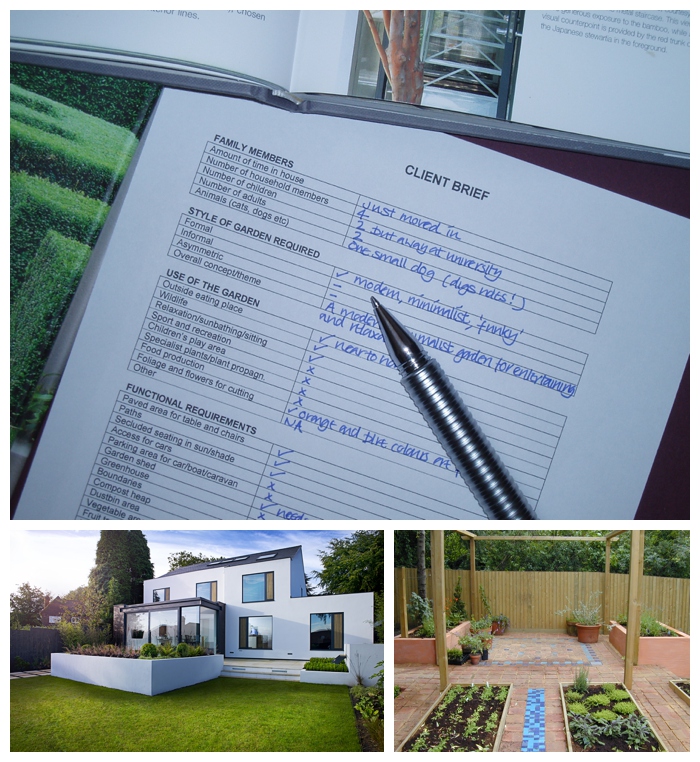
• Identify your preferred style & theme & create a mood board to capture its essence
Your garden is an extension of your house (linking outside and inside), you and your lifestyle, so use magazines and books, pinterest the internet etc for inspiration and use this in every aspect of the garden design process (the overall look; hard materials and planting)-Consider the style of garden as well as your overall theme. For example, do you want a modern minimalist garden for relaxing and entertaining or an organic naturalistic garden for wildlife? I clearly define the style and theme early on in the design process with clients, as it’s an important driver of the design process.
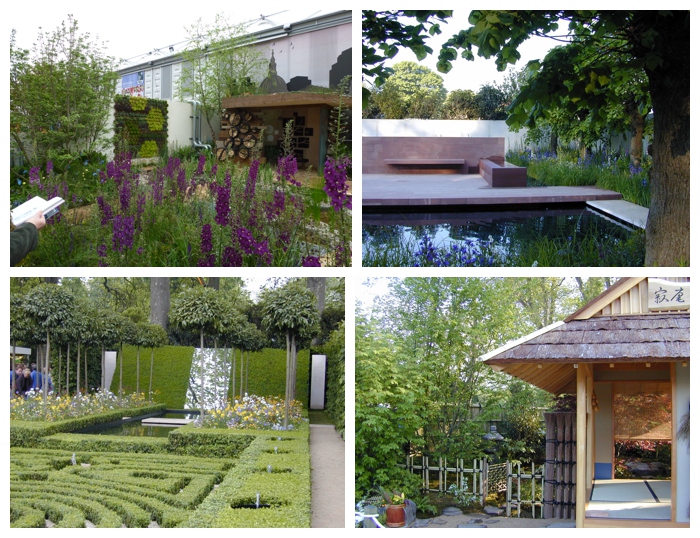
• Get to know your plot
It is really important to get to know your plot, its opportunities and limitations so that you can make the most of it and create a sense of place. If you have recently moved into your property, you may want to spend a year getting to know and understand your garden and changes throughout the seasons. Conduct a detailed assessment of your garden that includes drawing a measured and scaled plan of your plot. This should show all existing detail including the house, boundaries, permanent features, trees and levels. Plots are rarely square and it is important to ensure accuracy. Then collect some key information including the house and its surroundings (is it rural or urban; do you want to retain stunning views or hide unsightly ones), how do you feel about the space? is it peaceful and enclosed or open and exposed. Determine the climate: what is its orientation? South and west facing plots tend to be warm and sunny whereas east and North facing ones are more shady and cooler. Observe which areas of the garden are in sun and which in shade; are there any cold areas? What is the soil like: is it sandy (grainy and free-draining) good loam or clay (heavy and dense in texture) and is it well or poorly drained? All of this is important information for planting design, drainage provision and construction.
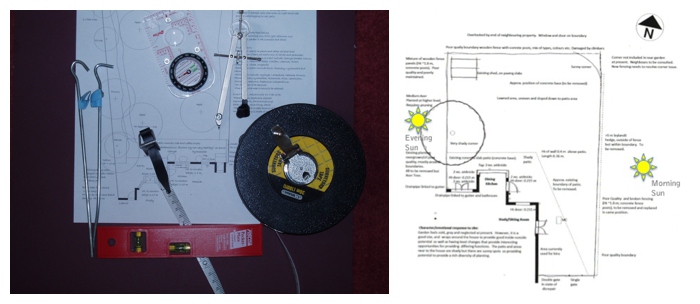
• Produce a diagram showing what will go where
This functional diagram enables you to map out where different elements of the garden are best suited based on your understanding of the site established through your site survey and analysis. The diagram provides a basis for further design and ensures that when you develop a layout, you locate the various elements in the most appropriate locations.
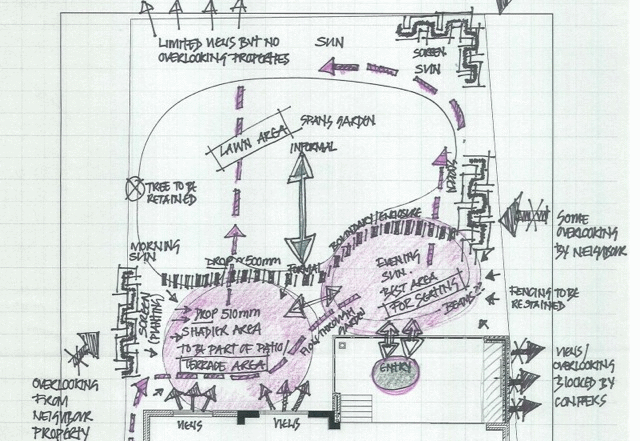
• Attention to detail and quality is everything
People appear to be investing in quality over quantity; finishing small spaces well and concentrating quality in specific areas in larger gardens. It is important to ensure that you use the best materials for the job and the best quality materials that you can afford. It is also important to understand the life-span of the products you use and their maintenance needs. Identify the key areas where quality is key and ensure that these are the main focus.

• Less is more: Keep things simple and uncluttered
This is critically important in the design of small spaces. Hard landscaping materials give the garden its main structure, introducing permanent colour and texture as well as evoking a design style. They should be introduced sparingly (typically 3 or at a push, 4 materials should be the maximum used in a garden), perhaps linking with the same materials or colour palette of the house, to ensure unity and coherence. Materials can be natural or man-made although there is a current trend towards more natural materials: wood, copper, natural stone that is locally sourced. If cost is critical then loose materials such as gravel maybe an effective option.
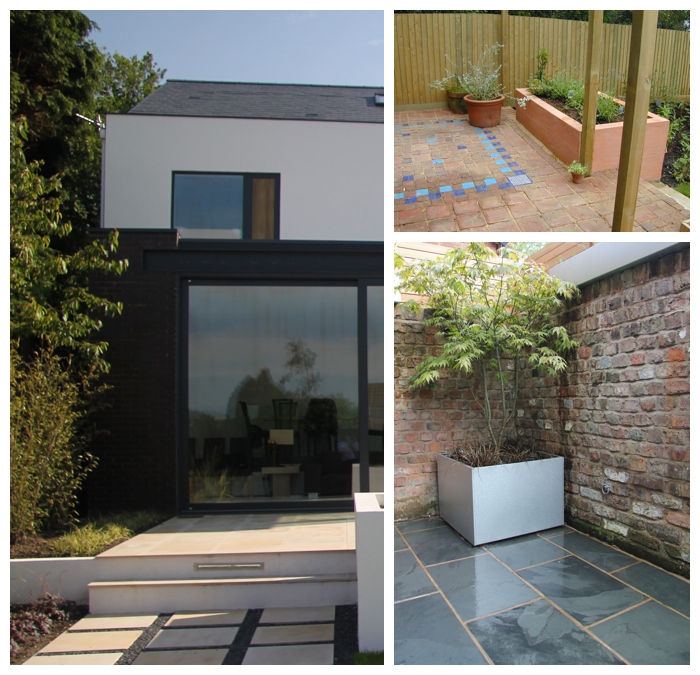
• Consider the contribution that boundaries will make to the overall garden
It entirely depends upon the setting and environment as to how boundaries should be treated and whether you want to ‘borrow the view’ or enclose and diminish the surroundings. In small gardens, boundaries can become a dominant and limiting feature and can cast shadow. To reduce their impact boundaries can be emphasized or disguised. A key way of softening their visual impact is to plant up the vertical structures and this greening will also blur the boundary and make a garden look larger. Above all, you should use your imagination because boundaries can transform a whole garden. Try out colour effects: hot or bright colours will emphasise them and make a space look smaller whilst cool or dark colours will visually enhance the apparent size of the garden. Finally consider boundaries to divide the space or add intrigue & suggest another area
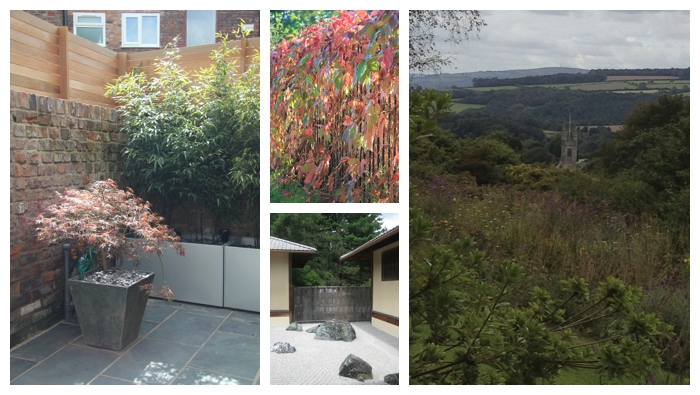
• Consider scale and proportion when designing
For example, ensure that the patio is of generous scale so that it forms a visual base for the house and is big enough for your furniture. As a guide, there needs to be at least 1 m either side of a table to accommodate a chair and for moving the chair back. If there are overhead beams or pergolas then these need to be at least 2.1 m high to provide sufficient headroom whilst posts must be carefully positioned such that 2 people could walk side-byside: a minimum of 1.5 m is required.
• Don’t forget focal points and the value they contribute to the garden
Focal points are anything attractive or unattractive that draws the eye. They provide interest and dimension to the garden and can include plants, containers, water features, structures and sculpture. Only one should be seen in a visual line and a series of focal points can be arranged around the garden to encourage movement.

• Ensure planting is chosen for its contribution to the overall scheme and fit with the style and concept of the garden.
Planting is critical to the success of a garden and needs to be more than a selection of your favorite plants if it is to fulfill its requirements. Plants define spaces; create enclosure & reinforce the mood or style of the garden as well as providing an array of functional, aesthetic & sensory benefits! One approach that I take, prior to looking through nursery catalogues, the web and books is to develop a plant profile. This allows you to produce a plant specification so you know what you are looking for in terms of planting type, season of interest, height etc. This information is then combined with more practical information (right plant right place ) to ensure the correct selection of appropriate plants. Planting design is a real skill in itself.
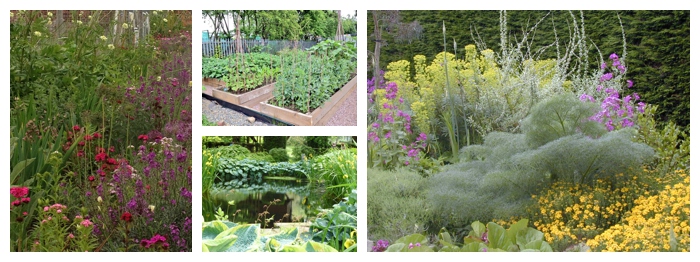
With this understanding under your belt, the layout can be developed. The garden layout plan relies on the use of geometry and the relationship and proportions of these shapes to the house, surroundings and each other. Squares and rectangles are useful in an urban setting where the garden may be small and narrow. A square is good for a seating area and long and narrow gardens can be successfully divided into three different areas. Circles are formal shapes but sinuous shapes can be derived from them and be informal and provide movement. Successful design often consists of similar shapes working together These shapes need to be turned into a real design with planting (masses) and pathways (voids) etc. reflecting the layout of your functional diagram. It isn’t a simple process, especially when changes of level are involved and you may need the help of a qualified landscape designer to ensure that the space works for you and you achieve a highly useable and manageable garden. Good luck!!
I am a garden designer and landscape architect based in the North West (www.poppyheadconsultancy.com) and blog regularly about aspects of garden and landscape design on my site. You can also follow me, Liz Ackerley on Twitter @poppyheadC, Pinterest or like my Facebook page where you will find lots of tips and ideas.
Poppyhead Consultancy recently won the Small Business Sunday Award (SBS) with Theo Paphitis (Dragon’s Den) (July 2013). They currently have a Garden Design offers package.

